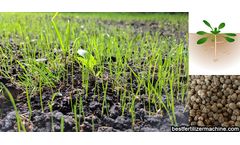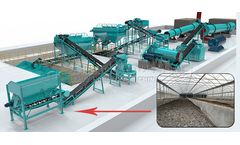Rhizosphere Articles & Analysis
15 articles found
After inoculating some strains of biological fertilizer, they become the dominant bacteria in the rhizosphere of crops due to their large-scale propagation in the roots of crops.They can secrete antibiotics against fungi and bacteria, so as to inhibit the growth of hyperactivity bacteria. ...
Be able to improve soil, improve product quality 3. It can improve the rhizosphere microbiota of crops and improve the disease and insect resistance of plants 4. ...
Extraction of soils with organic acids common to the maize rhizosphere suggested that organic acid exudation can readily mobilize Sb bound by organic Fe complexes. ...
From initial results and observations it is apparent that the BioCat+ treated digestate has an improved symbiotic effect in the crop rhizosphere. Crops of wheat and maize recently harvested have shown increases in yields of up to 23% higher yields than previously achieved on the respective lands. ...
The present review focuses on the influences of macrophytes on (i) Hg speciation and distribution in sediments, the rhizosphere and the water column, (ii) Hg transformation, and (iii) Hg release to the environment, including transfer to the trophic web. ...
Although the main living places for endophytic fungi were host tissues, they closely associated with rhizospheric soil. In this review, the effects of endophytic fungi on soil chemical, microbial and physical environment has been evaluated to provide useful information of improving soil environment by fungal physical function during the mycelia growth and biochemical function in ...
Furthermore, the pyrene and lead concentrations in the root tissues were significantly higher (P Keywords: spiked soil, pyrene, degradation, rhizosphere, non-rhizosphere, ageing process, ryegrass, plant uptake, translocation, lead, soil-to-plant transfer, biomass, root tissues, soil contamination, environmental ...
Therefore in this type of CW, the main phenol removal active fraction could be attributed to plant roots' biofilm bacteria.Keywords: biofilm, constructed wetland, gravel, microbial activity, phenol, ...
A robust, simple, rapid, and effective method was developed for extracting RNA from rhizospheric soil and ECMs by adapting previous grinding and lysis methods. ...
These changes occur through effects of legume seed exudates, rhizosphere exudates, and decomposing crop residues. The legume–Rhizobium symbiosis results in dinitrogen (N2) fixation that adds plant available N into the soil system. ...
A 60-week mesocosm study with a factorial arrangement of soil type, loamy sand (LS) and clay loam (CL), and E+ and E− tall fescue was conducted to determine if the soil microbial communities were affected by the presence of the endophyte. Bulk and rhizosphere soil samples were fixed in paraformaldehyde, and prepared for total direct microbial counts, and with a combination ...
The most widely studied group of PGPB are plant growth-promoting rhizobacteria (PGPR) colonizing the root surfaces and the closely adhering soil interface, the rhizosphere. As reviewed by Kloepper et al. or, more recently, by Gray and Smith, some of these PGPR can also enter root interior and establish endophytic populations. ...
The effect of transgenic Bt 176 maize on the rhizosphere bacterial community has been studied with a polyphasic approach by comparing the rhizosphere of Bt maize cultivated in greenhouse with that of its non transgenic counterpart grown in the same conditions. In the two plants the bacterial counts of the copiotrophic, oligotrophic and sporeforming bacteria, and ...
The aim of this study was to investigate potential effects on the composition of the bacterial and fungal diversity in rhizosphere and soil of a transgenic potato line (SIBU S1) which was modified in its starch composition by RNA anisensing, compared to the non-transgenic parental cultivar (SIBU) at the flowering stage in 2000. ...
Tubers from the magainin-expressing transgenic potatoes, however, had significantly lower total numbers of bacteria than tubers produced by unmodified plants. In vitro testing of rhizosphere isolates against magainin analogues found that bacterial isolates varied in their susceptibility to the peptides. ...









